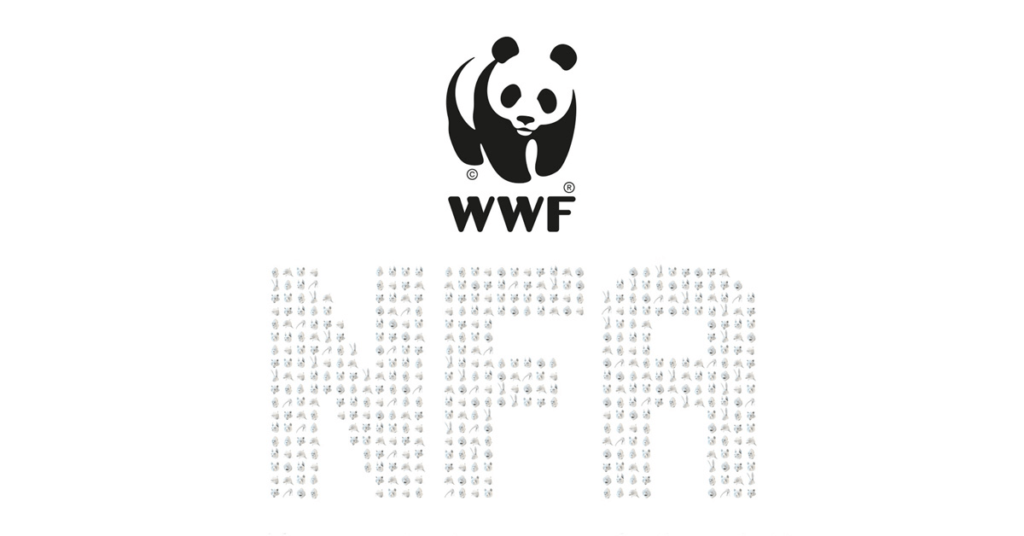While browsing nominations for the Webby Awards, I noticed an exceptionally original campaign: Non-Fungible Animals (NFA).
Riding the wave of interest around NFTs (Non-Fungible Tokens), WWF Germany has launched an innovative campaign with renowned digital artists to raise awareness for endangered species.
Each piece of art is limited to the number of animals in real life, and digital tokens (NFT certificates) ensure that the art remains unique and forgery-proof.
The campaign set the scene for WWF Germany to highlight the plight of the animals, while starting a much-needed conversation about the environmental sustainability of blockchain.
I met with Karl Nowak of WWF Germany, the creator of the NFA – Non-Fungible Animals campaign, to find out more.
Our conversation highlights the opportunities in this new virtual space as well as the challenges that any other organisation should keep in mind if looking to launch an NFT campaign of their own.
Q. How did you come up with the idea for the campaign?
I’m coming from the music and entertainment industry so my whole environment is very creative and innovative.
A friend of mine suggested that we do something with NFTs, and I thought it was a great idea. However, it had to be well planned and structured as a carbon neutral campaign that could raise awareness towards the plight of endangered animals, instead of simply trying to raise funds.
I remembered a campaign by WWF Japan 10 years ago called “Population by Pixel” where they launched posters of endangered animals. The poster of pandas was only 1,600 pixels, because only 1,600 pandas exist in the wild. The message was that 1,600 is not enough.
With this campaign in mind, I suggested that we do something similar with NFTs, so we took the concept and developed some impressive partnerships to build the campaign.
We started working on it about a year ago, in April 2021, and then over the summer we kept pushing harder and harder and then released it finally by the end of the year in November 2021.
Q. What were the main challenges?
There were only challenges! [laughter]
Internally at the WWF very few people fully understood what we were doing. I was criticised initially because when people hear about NFTs, many will think it’s a scam or they will associate it with Bitcoin, and they won’t differentiate between cryptocurrencies and NFTs, which is understandable because they are both using technologies on the blockchain.
Many people don’t know that there are different blockchains. So when we were writing the concept for the campaign, we had to think about these issues and everything that could backfire.
Web3 is fairly new and it’s moving extremely fast, so educating stakeholders about what you are doing is essential.
The challenge right now is that if Bitcoin wins the race to becoming the leading crypto payment solution, we have a problem because Bitcoin is extremely resource negative and needs so much energy, and its carbon footprint is ridiculously high.
That was one of our very first goals: to educate the outside world and prove that there are different ways to use the technology, in a smarter and environmentally sustainable way.
We used Polygon, an eco-friendly blockchain. In contrast to other cryptocurrencies, Polygon has very low energy consumption. It’s optimised for eco-friendly NFTs and is constantly being improved in terms of energy consumption.
Web3 is fairly new and it's moving extremely fast, so educating stakeholders about what you are doing is essential.
Karl Nowak Tweet
Q. Education on the environmental impact of cryptocurrencies is also one of the goals of the campaign?
Yes, it was one of the very first objectives.
Initially, we knew that education was going to be part of the NFA campaign, but I didn’t think it was going to be such a huge part. It’s so important to allow people to understand our intentions and integrate this into all our communications.
Raising awareness towards the extinction of animals and WWF’s work is still the main focus of the campaign, but education on establishing a “green” blockchain is important as well.
Q. Have you reached your objectives? Is the campaign still ongoing?
It is still ongoing. We are keeping it online, even after the UK campaign withdrawal, and in the meantime we are reviewing our position in this whole space.
Having said this, overall I’m very satisfied with how the campaign went. It is already a great success; we had over 75 million new contacts signing up to the campaign and we raised €269,449 so far. We are winning the first prize of many awards right now, which is a nice sign of appreciation as well.
In the end, we raised a lot of awareness and we’ve shown that there is a different way of approaching Web3, not by destroying the planet but by intentionally leveraging new technologies in a smarter way. So in this case it was definitely very successful for us.
Raising awareness towards the extinction of animals and WWF’s work is still the main focus of the campaign, but education on establishing a “green” blockchain is important as well.
Karl Nowak Tweet
Q. What was the target audience for the campaign? Did you focus on the crypto community, the financial industry or the general population?
The WWF is a mass-market organisation, so it was clear from the very beginning: if we are moving into this space, we’re going to communicate to the general population. Our idea was to bring NFTs to the mass market, so everything we built communications-wise was focused on the mass market; trying to explain it to newcomers and allowing them to make an easy entry into the world of crypto.
That’s why we’ve chosen a wallet that is simple, allowing you to easily create an account through your Facebook login or Google account. It’s not the best wallet but it was the easiest to use.
Most of the people will have been introduced to NFTs for the very first time and many will not buy one, but that wasn’t the main objective of the campaign anyway. We received a great deal of positive messages from people who said that they never had an NFT and the campaign is so amazing. Many of them were buying their first NFT through us and supporting us in this way because they really appreciated our innovative approach.
So in terms of raising awareness, it was a big success, reaching target groups that we probably wouldn’t have tackled in the classical way.
Q. What were the main channels for the campaign? Did you mostly focus on social media, online advertising or traditional PR?
PR was huge. WWF Germany is a national organisation, so essentially our PR was German-focused. We also approached the NFT and crypto-related news outlets, which went pretty well in a space where usually you can’t get coverage without budget, but that’s a good thing about being an NGO, right?
We didn’t have any paid media at all. We had a very broad mix of non-paid media outlets, from PR to social media to really specific channels. We also launched an NFA Community on Discord to bring together supporters online.
We had a very broad mix of non-paid media outlets, from PR to social media to really specific channels. We also launched an NFA Community on Discord to bring together supporters online.
Karl Nowak Tweet
Q. Did you work with influencers to spread your message?
We didn’t work with influencers, but an artist like Bosslogic, one of the leading Marvel and DC Comics artists, is an influencer by himself. For example, his Instagram post reached over 2 million people. That’s quite influential, right?
Q. Was there an impact of the pandemic on the campaign? You launched right at the beginning of the Omicron wave…
Since the campaign was digital, the digital marketplace was more influential than what was occurring in the outside world. During this time many things were happening within the crypto and NFT space: Bitcoin was no longer the lead currency, NFT regulations were increasing and now with the Ukraine war we are seeing major fluctuations in cryptocurrencies.
Having said this, we are now planning some activities in the non-digital world that we will most probably do this year, like MeetUps or exhibitions in art galleries. We have been contacted by well-known galleries that are willing to display the NFAs, be part of the journey and support us in this campaign.
So there is potential in the non-digital world, but everything Corona-related hasn’t had a big impact.
Q. Apart from events, do you plan on developing new content around this campaign?
Web3 is all about trust and transparency so we want to show, in a more transparent way, what has happened with the whole process of collecting the campaign funds and how it is being used. It is a storytelling opportunity to show supporters how our work is being done.
The NFT technology is in the early stages right now. There are so many technologies and possibilities popping up within this space, such as how the blockchain is used, what you can attach to an NFT and so on.
There is an opportunity for community-building using cryptocurrencies, with the possibility to bring together investors who want to support environmental issues. That’s the bigger picture here and represents a potential future approach on a meta level.
Q. What have you learned from the campaign, what would you improve and what would be your recommendations for anyone interested in launching a similar NFT campaign?
Many people approaching me don’t understand the complexity of these projects. One of my biggest recommendations would be: Get to know what you’re dealing with because there are many things that you need to anticipate when planning an NFT launch. You’re dealing with wallet issues, tax issues, IP rights, community building… basically you’re dealing with so many different things all at once.
Selling an NFT is actually the simple part, it can be done in an hour. I can create a picture and then go on OpenSea.io to mint it and then put it online. But it’s similar to the music industry where you are competing daily with 40,000 new songs being released on Spotify, it’s a very competitive marketplace.
The process is not just releasing it, it’s everything that goes with it: having a good idea, having a good understanding of your target group, having a purpose and monitoring it as it evolves, because everything online changes very, very fast.
If I were to do it again, I would shift the focus of the second drop more on education, and I would focus more on the crypto community – as well as the mass-market audience.
There is an opportunity for community-building using cryptocurrencies, with the possibility to bring together investors who want to support environmental issues. That's the bigger picture here and represents a potential future approach on a meta level.
Karl Nowak Tweet
Q. Will you be communicating further on the importance of cryptocurrencies to be more environmentally friendly?
Definitely. Just think: if more countries like Salvador adopt Bitcoin as an official currency, we’re duped. Having such an energy-intense Blockchain as a go-to payment solution for every single chewing gum package people buy could have very negative impacts on the environment, it would be a nightmare.
We definitely need to win this race by showing alternatives to the actual status quo, to positively influence the adoption of cryptocurrencies and the knowledge about the environmental impact of certain currencies.
We would therefore like to dig more into how to better use these technologies so that they may be greener and as carbon neutral as possible.
I’m currently part of an internal working group helping to define the strategy of WWF worldwide on crypto and NFTs. I’m making an effort to make ourselves look smart in this space, but it is definitely a process and there are many challenges.
If we get it right, it could be a game-changer. We could be at the forefront of defining these new technologies and help to raise awareness of the importance of climate-positive cryptocurrencies for the next decades.
Vote for WWF’s Non-Fungible Animals campaign at the Webby Awards here.
Latest blog posts

Exploring the AGILE Framework
In an interview for the Stories & Strategies podcast, I explain why agility is essential to succeed in today’s digital landscape.

Top 5 Proven Communications Strategies To Fight Disinformation
Strategies every communications leader should consider to prevent disinformation, complete with real-world examples and case studies.

How Patagonia’s digital advocacy campaigns are driving real-world impact
Find out about Patagonia’s approach to digital advocacy in this interview with Digital Community Manager Lauren Henshaw.


